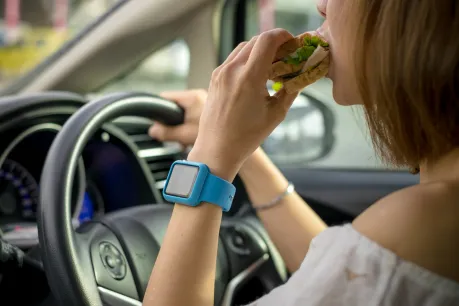Distracted Driving: More Than Just Texting

Injured?
Be their hero behind the wheel. Hear John Morgan’s powerful message on safe driving—click here to watch.
We’ve all heard it before: “Don’t text and drive!” It’s one of the most talked-about safety messages today, and for good reason. But distracted driving is much more than just sending that “on my way” text or scrolling through Instagram at a stoplight.
In reality, distractions come in all shapes and sizes—whether it’s spilling your coffee, fiddling with your GPS, or finding the perfect playlist while cruising down the highway. Distracted driving is a serious problem, but with a little awareness (and some clever tips), you can keep yourself and your loved ones safe.
What Exactly Is Distracted Driving?
Distracted driving is any activity that takes your attention away from the road. There are three main types of distractions:
- Manual distractions: Taking your hands off the wheel, like when you’re reaching for that dropped fry.
- Visual distractions: Taking your eyes off the road, like when you glance at your GPS to check if you missed that turn.
- Cognitive distractions: Taking your mind off driving, like when you’re deep in thought replaying that embarrassing thing you said last week.
While texting combines all three types, a host of other activities also fall under distracted driving. Let’s explore some of these lesser-known distractions that could make you (and your passengers) vulnerable on the road.
The Not-So-Obvious Distractions
Eating and Drinking
Ever tried to balance a sandwich in one hand and steer with the other? Eating on the go seems harmless, but it’s one of the most common driving distractions. In fact, studies show that a whopping 70% of drivers admit to eating behind the wheel. Spilling a drink or fumbling with food wrappers can easily lead to an accident—so maybe finish that burger before you hit the gas.
GPS Navigation
While GPS is a lifesaver for finding your way, it can also be a dangerous distraction. Adjusting your route or reading a map on your phone pulls your eyes from the road. The solution? Set your route before you leave, and if you need to make changes, pull over. Don’t let a missed exit turn into a missed safety opportunity.
Passengers
Believe it or not, chatting with your passengers can also be a distraction. This is especially true for teens and young drivers, where studies show that driving with friends can significantly increase the chances of a crash. Keep conversations light, and make sure they know your focus is on the road—not on their latest drama.
Pets in the Car
As much as we love our furry friends, pets can be a major distraction. A loose dog hopping from seat to seat or a cat weaving around the dashboard can take your attention away from driving. Make sure your pets are secured in a carrier or with a pet seat belt to avoid any “ruff” surprises.
Personal Grooming
You’re running late for that big meeting, and what better time to apply your makeup than at a red light? Not so fast! Personal grooming behind the wheel is more common than you’d think, from fixing your hair to shaving. No matter how much time you think you’re saving, it’s not worth the risk.
Why It Matters: The Statistics
The numbers don’t lie—distracted driving is a major cause of accidents in the U.S. According to the National Highway Traffic Safety Administration (NHTSA), distracted driving claimed 3,142 lives in 2020 alone. That’s nearly nine people a day. While texting is a leading cause, distractions like eating and GPS use also contribute to the growing problem.
Tips to Stay Focused
The good news? Distracted driving is 100% preventable. Here are some simple ways to make sure you (and your superhero family) stay focused on the road:
- Prepare before you drive: Set your GPS, adjust your mirrors, and finish that breakfast burrito before hitting the road.
- Keep your phone out of reach: Put your phone on “Do Not Disturb” or keep it in the glove box to avoid the temptation of checking notifications.
- Get a co-pilot: If you have passengers, ask them to handle the GPS or change the music so you can focus on driving.
- Take breaks: On long drives, pull over to eat, stretch, or handle any distractions that pop up. It’s better to take a few extra minutes than risk an accident.
Be Their Hero: Lead by Example
Remember, your kids are always watching. Whether they’re in the back seat or getting ready to drive themselves, they learn their habits from you. By making safe driving a priority, you’re setting the standard for how they should behave behind the wheel.
At Morgan & Morgan, we understand the devastating impact that distracted driving accidents can have on families. If you or a loved one has been injured due to distracted driving, our team of attorneys is here to help you get the compensation you deserve.
Safe driving starts with you—so be the hero your kids see every day. Stay focused, stay safe, and set the right example.

We've got your back
Injured?
Not sure what to do next?
We'll guide you through everything you need to know.

